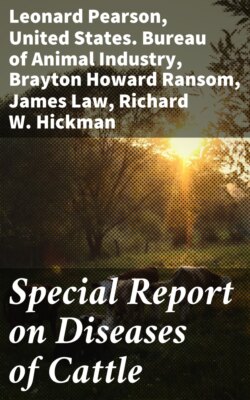Читать книгу Special Report on Diseases of Cattle - Lowe - Страница 38
На сайте Литреса книга снята с продажи.
INFECTIOUS DIARRHEA; WHITE SCOUR. [See chapter on Diseases of young calves, p. 247.] GASTROENTERITIS.
ОглавлениеThis consists of an inflammation of the walls of the stomachs and of the bowel.
Gastroenteritis, or inflammation of the walls of the stomachs and intestines, follows upon irritations more severe or longer continued than those that produce gastrointestinal catarrh.
Causes.—Severe indigestion may be followed by gastroenteritis, or it may be caused by swallowing irritant poisons, such as arsenic or corrosive sublimate or irritant plants. Exposure to cold or inclement weather may produce the disease, especially in debilitated animals or animals fed improperly. It is asserted that if cattle feed on vegetation infested with some kinds of caterpillars this disease may result.
Symptoms.—Dullness; drooping of the ears; dryness of the muzzle; dry skin; staring coat; loins morbidly sensitive to pressure; fullness of the left flank, which is caused by the distention of the fourth stomach by gas. The pulse is small, the gait is feeble and staggering; each step taken is accompanied with a grunt, and this symptom is especially marked if the animal walks in a downward direction. There is loss of appetite, and rumination is suspended. The passages at first are few in number, hard, and are sometimes coated with mucus or with blood. Later a severe diarrhea sets in, when the passages contain mucus and blood and have an offensive odor. There is evidence of colicky pain, and the abdomen is sensitive to pressure. Pain may be continuous. There is fever and acceleration of pulse rate and respirations. Mental depression and even insensibility occur before death. The disease is always severe and often fatal.
Post-mortem appearances.—The mucous membrane of the fourth stomach has a well-marked red color and sometimes presents ulcerations. The wall is thickened and softened, and similar conditions are found in the walls of the intestines. The red discoloration extends in spots or large areas quite through the wall, showing on the outside.
Treatment.—Very small quantities of carefully selected feed must be given and the appetite must not be forced. Protect the animal well from cold and dampness. Internally, give linseed tea, boiled milk, boiled oatmeal gruel, or rice water. These protectives may carry the medicine. Tannopin in doses of 30 to 60 grains is good. Subnitrate of bismuth in doses of 1 to 2 drams may be given. Pulverized opium may be used, if the diarrhea is severe, in 1 to 2 dram doses. If the bowel movements are not free, one may give from a pint to a quart of castor or raw linseed oil.
